Brown's Guest House, Oxford, Friday afternoon, 11 August 2000:
 Yesterday morning we drove in to the older and more interesting center of Ludlow. Stas visited a wool (yarn) store, her favorite kind, while the rest of us picked up some token presents for her birthday. We then had tea and gave her the presents at a place called DeGrey's, which earns approving mention for being the only place so far in the British Isles where we've yet been served tea brewed without tea bags. In the old days, though, when tea bags were all but unknown, we could only have procured coffee at that particular hour. (Shown here is one of Ludlow's finer specimens of half-timbered building.)
Yesterday morning we drove in to the older and more interesting center of Ludlow. Stas visited a wool (yarn) store, her favorite kind, while the rest of us picked up some token presents for her birthday. We then had tea and gave her the presents at a place called DeGrey's, which earns approving mention for being the only place so far in the British Isles where we've yet been served tea brewed without tea bags. In the old days, though, when tea bags were all but unknown, we could only have procured coffee at that particular hour. (Shown here is one of Ludlow's finer specimens of half-timbered building.)
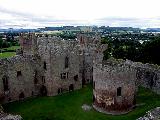
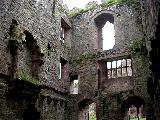 Next we visited Ludlow castle, which struck us as just the perfect sort of castle: in just the right degree or state of ruin, sufficiently grand in scale without being sprawling, and by no means overrun with us tourists and those who seek to guide or sell to us. At the height of its importance it was the seat of the great Roger Mortimer, Lord of the Marches. He had the palatial "North Range" built against the inner bailey wall, as seen on the left of the photo at left (shot from the top of the gatehouse keep); at the farthest left you can see the Great Hall, along with just a corner of the stair leading up to it. It was in this Great Hall, a few centuries after it was built, that Milton's masque Comus was first performed. The photo at right is an interior view of what would have been rooms at various levels adjoining the Great Hall. We are here looking back in the general direction of the keep, and you can match the configuration of windows between the two photos.
Next we visited Ludlow castle, which struck us as just the perfect sort of castle: in just the right degree or state of ruin, sufficiently grand in scale without being sprawling, and by no means overrun with us tourists and those who seek to guide or sell to us. At the height of its importance it was the seat of the great Roger Mortimer, Lord of the Marches. He had the palatial "North Range" built against the inner bailey wall, as seen on the left of the photo at left (shot from the top of the gatehouse keep); at the farthest left you can see the Great Hall, along with just a corner of the stair leading up to it. It was in this Great Hall, a few centuries after it was built, that Milton's masque Comus was first performed. The photo at right is an interior view of what would have been rooms at various levels adjoining the Great Hall. We are here looking back in the general direction of the keep, and you can match the configuration of windows between the two photos.
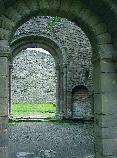 On the right in the view from the keep (above left) you look down on a highly unusual round Norman chapel nave. Here is a view through that round nave, showing a larger Norman archway beyond an opposite and smaller one, plus one bay of the blind arcade for seating inside, and a carved face corbel left over from a time when they put in a floor there (supposedly so as to bring the most literal form of upstairs/downstairs class distinction into their place of worship).
On the right in the view from the keep (above left) you look down on a highly unusual round Norman chapel nave. Here is a view through that round nave, showing a larger Norman archway beyond an opposite and smaller one, plus one bay of the blind arcade for seating inside, and a carved face corbel left over from a time when they put in a floor there (supposedly so as to bring the most literal form of upstairs/downstairs class distinction into their place of worship).
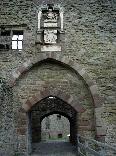 The entrance shown at left faces the moat bridge and goes from the outer to the inner bailey through the gatehouse keep. I can only guess at the function of the iron hoop just above the doorway; I searched the coat of arms above it in vain for a defiant Latin motto translatable as "Lancastrians can't jump" or anything similar.
The entrance shown at left faces the moat bridge and goes from the outer to the inner bailey through the gatehouse keep. I can only guess at the function of the iron hoop just above the doorway; I searched the coat of arms above it in vain for a defiant Latin motto translatable as "Lancastrians can't jump" or anything similar.
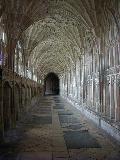
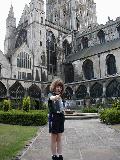 The news that the film version of Harry Potter was to be filmed with Gloucester Cathedral standing in for Hogwarts School of Witchcraft & Wizardry made Larissa plenty keen to visit this morning. I do not pretend to know from thaumaturgical academies, but as a cathedral it is a wonderful palimpsest of all the styles of all the different medieval periods from Norman to Perpendicular, with medieval architects' jury-rigs, compromises, and improvisations everywhere apparent, much to Stas's delight. The fan-vaulted cloister featured in both these photos is almost sure to feature prominently as a set in the film. Here you see Larissa practising basic froggification.
The news that the film version of Harry Potter was to be filmed with Gloucester Cathedral standing in for Hogwarts School of Witchcraft & Wizardry made Larissa plenty keen to visit this morning. I do not pretend to know from thaumaturgical academies, but as a cathedral it is a wonderful palimpsest of all the styles of all the different medieval periods from Norman to Perpendicular, with medieval architects' jury-rigs, compromises, and improvisations everywhere apparent, much to Stas's delight. The fan-vaulted cloister featured in both these photos is almost sure to feature prominently as a set in the film. Here you see Larissa practising basic froggification.
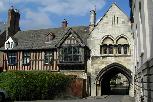
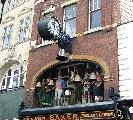 Also in Gloucester we encountered this rosy-tinted half-timbered house in the cathedral close, and (out in town) this ornate clock advertising a watchmaker, with automata representing the four kingdoms of the British Isles plus Father Time. (Is Ireland honored or merely stereotyped by being shown always to strike the first blow?) A very brief while after this photo was taken, we realized that the clock's visible splendors had left no room in the budget for tuning the chimes.
Also in Gloucester we encountered this rosy-tinted half-timbered house in the cathedral close, and (out in town) this ornate clock advertising a watchmaker, with automata representing the four kingdoms of the British Isles plus Father Time. (Is Ireland honored or merely stereotyped by being shown always to strike the first blow?) A very brief while after this photo was taken, we realized that the clock's visible splendors had left no room in the budget for tuning the chimes.

 Trevor and Larissa exhibited an appropriately studious streak our first afternoon in Oxford, as we rested in our B&B room between laundry and dinner. Now, if only PoKéMoN and Harry Potter were mainstays of the Oxonian curriculum!
Trevor and Larissa exhibited an appropriately studious streak our first afternoon in Oxford, as we rested in our B&B room between laundry and dinner. Now, if only PoKéMoN and Harry Potter were mainstays of the Oxonian curriculum!
previous entry
next entry
main/ToC page

 Next we visited Ludlow castle, which struck us as just the perfect sort of castle: in just the right degree or state of ruin, sufficiently grand in scale without being sprawling, and by no means overrun with us tourists and those who seek to guide or sell to us. At the height of its importance it was the seat of the great Roger Mortimer, Lord of the Marches. He had the palatial "North Range" built against the inner bailey wall, as seen on the left of the photo at left (shot from the top of the gatehouse keep); at the farthest left you can see the Great Hall, along with just a corner of the stair leading up to it. It was in this Great Hall, a few centuries after it was built, that Milton's masque Comus was first performed. The photo at right is an interior view of what would have been rooms at various levels adjoining the Great Hall. We are here looking back in the general direction of the keep, and you can match the configuration of windows between the two photos.
Next we visited Ludlow castle, which struck us as just the perfect sort of castle: in just the right degree or state of ruin, sufficiently grand in scale without being sprawling, and by no means overrun with us tourists and those who seek to guide or sell to us. At the height of its importance it was the seat of the great Roger Mortimer, Lord of the Marches. He had the palatial "North Range" built against the inner bailey wall, as seen on the left of the photo at left (shot from the top of the gatehouse keep); at the farthest left you can see the Great Hall, along with just a corner of the stair leading up to it. It was in this Great Hall, a few centuries after it was built, that Milton's masque Comus was first performed. The photo at right is an interior view of what would have been rooms at various levels adjoining the Great Hall. We are here looking back in the general direction of the keep, and you can match the configuration of windows between the two photos.
 Yesterday morning we drove in to the older and more interesting center of Ludlow. Stas visited a wool (yarn) store, her favorite kind, while the rest of us picked up some token presents for her birthday. We then had tea and gave her the presents at a place called DeGrey's, which earns approving mention for being the only place so far in the British Isles where we've yet been served tea brewed without tea bags. In the old days, though, when tea bags were all but unknown, we could only have procured coffee at that particular hour. (Shown here is one of Ludlow's finer specimens of half-timbered building.)
Yesterday morning we drove in to the older and more interesting center of Ludlow. Stas visited a wool (yarn) store, her favorite kind, while the rest of us picked up some token presents for her birthday. We then had tea and gave her the presents at a place called DeGrey's, which earns approving mention for being the only place so far in the British Isles where we've yet been served tea brewed without tea bags. In the old days, though, when tea bags were all but unknown, we could only have procured coffee at that particular hour. (Shown here is one of Ludlow's finer specimens of half-timbered building.)






